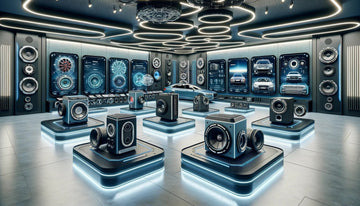
Premium Sealed Subwoofer Enclosure Guide
Are you tired of lackluster bass performance from your car audio system? Look no further than a sealed subwoofer enclosure. This comprehensive guide will provide all the information you need to choose and optimize a sealed subwoofer enclosure for your car audio system. Explore different types of enclosures, including enclosure boxes and sealed subwoofer boxes, and discover the benefits of a sealed design
Key Takeaways
- Sealed subwoofer enclosures provide deep and precise bass reproduction
- There are different types of sealed subwoofer enclosures, including enclosure boxes and sealed subwoofer boxes
- Choosing the right size and material for a sealed subwoofer enclosure is essential for optimal performance
- Integrating a sealed subwoofer enclosure into your car stereo system can enhance your overall audio experience
- Troubleshooting common issues with sealed subwoofer enclosures can help ensure optimal performance
Understanding Sealed Subwoofer Enclosures
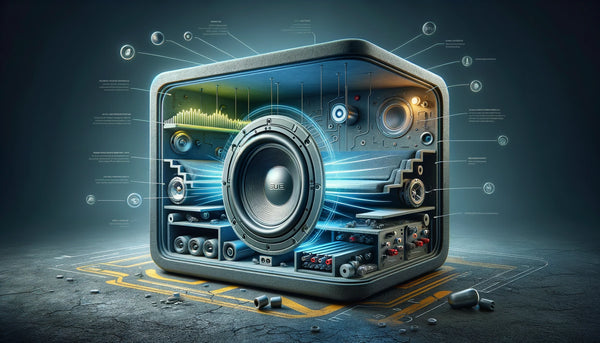
If you're a car enthusiast or audio lover, you're likely familiar with sealed and ported subwoofer enclosures. Understanding the differences between these two types can be crucial to enhancing your audio experience.
A sealed subwoofer enclosure is an utterly airtight box, with the subwoofer mounted in a sealed chamber. On the other hand, a ported subwoofer enclosure has a vent or port that allows air to escape, creating more volume and deeper bass.
While both have advantages, a sealed subwoofer box has unique characteristics that make it an excellent option for specific audio setups. Its sealed design allows for more precise bass reproduction, with fewer vibrations and distortion.
If you're considering a sealed subwoofer enclosure, choosing an enclosed box specifically designed for a sealed application is essential. These boxes are designed to control the subwoofer's movement better and produce more accurate bass.
Choosing the Right-Sealed Subwoofer Enclosure

Choosing the proper sealed subwoofer enclosure is vital to achieving optimal sound quality and bass performance. When selecting a sealed enclosure, there are several vital factors you need to consider.
- Subwoofer Size and Type: The first step is to match the subwoofer to the enclosure size. Single 10 inch and single 12 inch subwoofers are commonly used in sealed enclosures. Ensure the enclosure is compatible with your subwoofer and that the enclosure volume is appropriate.
- Enclosure Volume: The enclosure volume is crucial in determining the bass response of your subwoofer. The recommended enclosure size can be found in the subwoofer manufacturer's manual. However, empty subwoofer enclosures allow you to customize and optimize the enclosure volume for your specific subwoofer.
- Enclosure Material: The material used to construct the sealed enclosure box impacts the overall sound quality. Sealed MDF (medium-density fibreboard) enclosures are commonly used as they provide excellent sound quality and durability.
Empty subwoofer enclosures offer several benefits for customizing and optimizing the enclosure for your specific subwoofer. Here are some benefits:
- Customization: You can adjust the enclosure volume and tuning frequency to achieve your desired bass response.
- Optimization: You can optimize the enclosure to match and enhance the performance of your subwoofer.
- Ease of Use: Empty subwoofer enclosures come pre-cut and ready to assemble, making installing your subwoofer quick and easy.
Sealed enclosure boxes can be made from various materials, including MDF, plastic, and fiberglass. However, MDF is the most popular due to its strength and durability. MDF-sealed subwoofer enclosures are known for their excellent sound quality, and professional car audio enthusiasts often use them.
| Material | Strength | Durability | Sound Quality |
|---|---|---|---|
| MDF | High | High | Excellent |
| Plastic | Low | Low | Poor |
| Fiberglass | High | Medium | Good |
Before purchasing a sealed subwoofer enclosure, ensure it is compatible with your subwoofer and meets your specific audio system requirements. By selecting the right enclosed subwoofer box and customizing it to your specific requirements, you can achieve an exceptional bass performance that elevates your car audio system.
Sealed vs. Ported: Which is Right for You?
Choosing between a sealed or ported subwoofer enclosure ultimately comes down to personal preference and the specific requirements of your audio system. Both designs have their unique advantages and disadvantages, and choosing the right one will depend on factors such as desired sound reproduction, power handling, and frequency response.
Let's take a closer look at the differences between a sealed and ported design:
| Design | Sealed | Ported |
|---|---|---|
| Sound Quality | Better transient response More accurate and precise bass reproduction Reduced distortion |
Greater efficiency and output Enhanced low-frequency extension More significant impact and "boom" factor |
| Power Handling | Less power handling than ported designs | Can handle more power than sealed designs |
| Frequency Response | Roll-off begins earlier Tighter and more controlled response in the low-end |
Can achieve a flatter response with proper tuning Extended low-end response |
As you can see, a sealed design offers several benefits, including improved transient response and reduced distortion. However, ported designs can handle more power and deliver greater efficiency and output. Ultimately, the decision between a sealed or ported enclosure will depend on your personal preferences and the specific requirements of your audio system.
Fun Fact: Did you know that subwoofers in sealed enclosures typically require less power to drive than those in ported enclosures due to their higher sensitivity?
"The sealed enclosure works best for accurate sound reproduction and is ideal for music genres such as rock, country, and jazz."
Exploring Subwoofer Size and Configuration
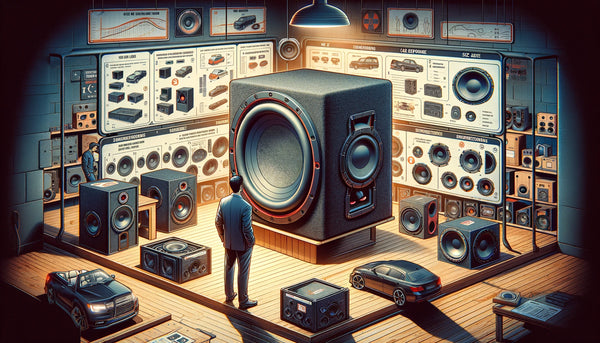
Choosing the right subwoofer size and configuration is crucial to achieving optimal performance from your sealed enclosure. The most common sizes for sealed subwoofers are single 12-inch- and 10-inch subwoofers, each with advantages and limitations.
If you're looking for deep, punchy bass with plenty of volume, single 12-inch subwoofers are a great choice. They typically require more power, but they're ideal for those who want a powerful and immersive bass experience. Single 10-inch subwoofers, on the other hand, are generally more efficient and require less power to operate. While they may not deliver the same level of rumbling bass as 12-inch subs, they're a perfect option if you're looking to balance bass output with overall sound quality.
For those looking for an even more immersive bass experience, dual-sealed subwoofer setups are worth exploring. These setups feature two subwoofers in the same sealed enclosure box, delivering more volume and bass than a single subwoofer setup. It's a great way to elevate your bass experience to the next level if you have the space and power to accommodate a dual setup.
Consider your specific car audio system needs and preferences when choosing the size and configuration of your subwoofer. Don't hesitate to experiment with different setups, positions, and configurations to find the best fit for your audio system and music taste.
Optimizing Your Sealed Subwoofer Enclosure
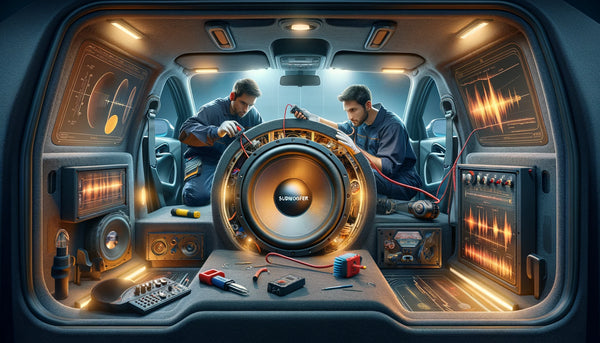
When optimizing your sealed subwoofer enclosure, there are a few best practices to ensure maximum performance. Proper positioning and installation techniques are critical to achieve optimal sound reproduction. Providing adequate air space and allowing the subwoofer to move freely within the enclosure is essential. This will ensure the subwoofer responds accurately and delivers the intended bass level without distortion or damage to the speaker.
One key factor to consider is the size of the woofer box. A larger box typically offers better low-frequency response, while a smaller box will increase efficiency. Choosing the right size for your subwoofer and car audio system requirements is essential.
Another factor to consider is the material used to construct the enclosure. Sealed MDF (medium-density fiberboard) is a popular choice due to its density and tight seal, but other materials, such as fiberglass and carbon fiber, can also be effective.
| Optimization Tip | Description |
|---|---|
| Choose the right box size | Match the box size to the subwoofer size and car audio system requirements |
| Provide proper air space | Ensure the enclosure provides enough air space for the subwoofer to move freely. |
| Use high-quality materials | Select high-quality materials such as sealed MDF, fiberglass, or carbon fiber to construct the enclosure. |
| Seal all seams and cracks. | Eliminate air leaks by sealing all seams and cracks with airtight tape or sealant. |
| Install in a vibration-free location. | Mount the enclosure in a vibration-free location, such as the trunk or rear of the car. |
By following these optimization tips, you can ensure that your sealed subwoofer enclosure delivers the best possible performance, allowing you to enjoy deep, precise bass reproduction in your car audio system.
Integrating a Sealed Subwoofer Enclosure into Your Car Stereo System
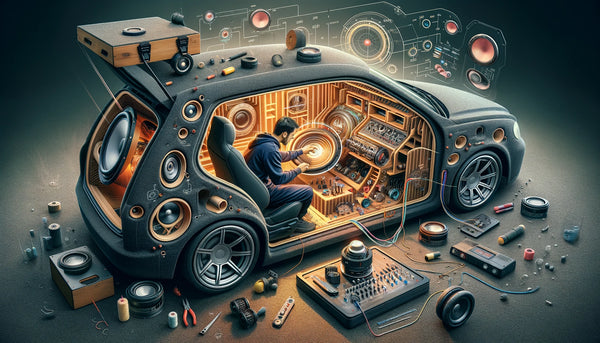
Installing a sealed subwoofer enclosure into your car stereo system is an excellent way to enhance your audio experience. To optimize the performance of your audio system, consider the following steps when integrating a sealed subwoofer enclosure:
- Choose the right car subwoofer boxes or sub enclosures to hold sealed subwoofers. Sealed subwoofer boxes help prevent vibrations and ensure better sound quality.
- Ensure that the audio system can handle the additional power and output of the new subwoofer. Upgrading the audio system with the new audio source may be necessary to guarantee optimal performance levels.
- Connect the woofers to a suitable amplifier that matches the sub's impedance in the enclosure box. This step ensures that the subwoofer will give the best performance.
- Correctly wire and connect the subwoofers to the amplifier or stereo system, following instructions that come with the system to avoid connectivity issues.
- Test the system to ensure it performs optimally regarding bass reproduction and overall sound quality.
Integrating a sealed subwoofer enclosure into your car stereo system may seem daunting. Still, you can quickly achieve the best results with these simple steps. Whether installing the sub enclosures yourself or having a professional do it for you, following these steps is essential to ensure the best audio experience possible.
Enhancing Your Car Audio Experience with a Sealed Subwoofer Enclosure
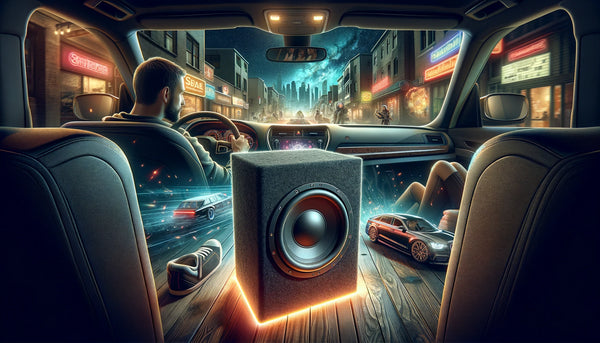
If you want to take your car stereo to the next level, consider adding a sealed subwoofer enclosure to your audio system. Incorporating a sealed subwoofer box can ensure improved bass response and sound quality in your vehicle. The enclosed design also helps maintain the balance and clarity of your car's audio system.
When adding a subwoofer to your car stereo, choosing the right size and type of subwoofer for your specific audio system requirements is essential. Consider factors such as the size of your car and the amount of space available for the subwoofer enclosure. Select a subwoofer that matches your car stereo's power output for optimum performance.
Another benefit of a sealed subwoofer enclosure is the ability to customize and optimize the enclosure for your specific subwoofer. You can experiment with different enclosure sizes and shapes to achieve the desired bass performance. An empty subwoofer enclosure allows you to install a subwoofer of your choice and adjust and fine-tune the enclosure to your preference.
To ensure optimal performance and sound quality, properly position and install your sealed subwoofer enclosure. Ensure adequate airspace and allow the subwoofer to move freely within the enclosure. Proper wiring and connection to your car stereo system are crucial to achieving the best possible bass response.
With the adequately sealed subwoofer enclosure and subwoofer in your car audio system, you can experience enhanced bass reproduction and overall sound quality. Upgrade your car stereo today with a sealed subwoofer enclosure.
Diving Deeper: Advanced Tips and Techniques for Sealed Subwoofer Enclosures
If you are a true audiophile, you know that the key to an exceptional car audio system lies in the details. This section will discuss some advanced tips and techniques for optimizing your sealed subwoofer enclosure to achieve the best possible sound quality.
The Advantages of MDF Sealed Subwoofer Enclosures
Nothing beats a medium-density fiberboard (MDF) when constructing a sealed subwoofer enclosure. Not only is it highly durable and resistant to moisture, but it also has excellent sound-deadening properties that can help to reduce unwanted vibrations and resonances. By using MDF, you can create a sealed subwoofer enclosure that delivers clean, accurate bass with minimal distortion.
Choosing the Right Type of Subwoofer
The type of subwoofer you choose can significantly impact the overall performance of your sealed subwoofer enclosure. When selecting a subwoofer, choose one specifically designed for a sealed application. This will ensure that the subwoofer is optimized for a sealed enclosure's air space and volume. In addition, consider the power handling capabilities of the subwoofer, as well as its frequency response range.
Troubleshooting Common Issues with Sealed Subwoofer Enclosures
Even with proper installation and optimization, issues may arise when using a sealed subwoofer enclosure. Here are some of the common problems you may encounter and how to troubleshoot them:
Problem: Subwoofer Overheating
A subwoofer can overheat due to excessive power or thermal compression. One way to prevent this issue is to ensure that the impedance and power handling of the subwoofer matches the amplifier and the sealed subwoofer enclosure. Another solution is adding a cooling fan, improving the subwoofer's heat dissipation. Consider using a dual voice coil subwoofer with higher power handling capabilities to reduce the risk of overheating.
Problem: Enclosure Vibrations
Enclosure vibrations may occur during playback and cause distortions or buzzing noises. This can happen if the sealed subwoofer enclosure is not securely fastened to the car or if the screws and fasteners are not tightened enough. Try adding more screws or reinforcing the enclosure with additional bracing materials such as MDF or plywood. Anti-vibration pads or mats can also alleviate vibrations and improve sound quality.
Problem: Distorted Bass Response
The distorted bass response can be caused by several factors, such as damaged or worn-out subwoofers, incorrect air space inside the enclosure, or poorly sealed enclosure joints. You can address this problem by checking the subwoofer cone and ensuring it is free from rips or tears. Correctly measuring and adjusting the air space inside the enclosure can restore clear and accurate bass response. Finally, check the enclosure for any gaps or leaks and seal them with silicone or caulk.
Optimizing Your Sealed Subwoofer Enclosure
With the proper installation and troubleshooting techniques, a sealed subwoofer enclosure can take your car audio experience to the next level. You can achieve optimal performance and long-lasting results by ensuring proper airflow, using high-quality materials, and selecting the right subwoofer. If you encounter any issues, follow the above solutions for everyday problems and optimize your sealed subwoofer enclosure for the best possible sound quality.
Conclusion
Congratulations on reaching the end of this comprehensive guide to sealed subwoofer enclosures. By now, you should clearly understand the benefits of choosing a sealed design and how to optimize it for the best possible bass performance.
Remember, when selecting a sealed subwoofer enclosure, it's essential to consider factors such as the size and type of subwoofer, the materials used for construction, and proper installation techniques. By taking the time to make informed choices, you can elevate your car audio experience and enjoy deep, precise bass reproduction.
Whether you're a seasoned audiophile or a newbie to the car audio scene, a sealed subwoofer enclosure can be a game-changer for your listening pleasure. Don't hesitate to experiment with different enclosures and configurations to find the perfect fit for your audio system.
Thank you for reading, and we hope you found this guide helpful. If you have any questions or comments, feel free to contact us. We wish you the best of luck in your quest for the ultimate bass experience!
FAQ
What is a sealed subwoofer enclosure?
A sealed subwoofer enclosure is a type of enclosure box specifically designed to house a subwoofer in a sealed environment. It is also known as a sealed subwoofer box. The sealed design provides a tight and controlled bass response, allowing for accurate and precise low-frequency reproduction.
How does a sealed subwoofer enclosure differ from a ported enclosure?
A sealed subwoofer enclosure is completely sealed, while a ported enclosure has a port or vent that allows air to escape. The sealed design of a sealed enclosure offers advantages such as improved transient response and reduced distortion. Ported enclosures are tuned to a specific frequency range and can produce louder bass but with reduced control.
What are the benefits of using a sealed subwoofer enclosure?
Sealed subwoofer enclosures offer several benefits. They provide accurate and tight bass reproduction, ensuring precise low-frequency response. They also have improved transient response, meaning they can easily handle fast and dynamic bass passages. Sealed enclosures typically have a smaller footprint, making them easier to install in various car audio systems.
How do I choose the proper sealed subwoofer enclosure for my car audio system?
When selecting a sealed subwoofer enclosure, consider factors such as the size and power handling capabilities of your subwoofer and the available space in your vehicle. You can choose an empty subwoofer enclosure, which allows you to customize and optimize the enclosure for your specific subwoofer. Additionally, please pay attention to the material used in the enclosure's construction, such as sealed MDF, as it can affect the sound quality.
Single 10 inch sub or single 12 inch woofer, Which is better, in a sealed enclosure?
Choosing between a single 12-inch or 10-inch subwoofer in a sealed enclosure depends on your preferences, available space, and desired bass response. Generally, a 12-inch subwoofer can produce more profound and powerful bass due to its larger size, while a 10-inch subwoofer may provide a tighter and punchier bass response. Consider your specific requirements and listen to different options to determine which size best suits your audio system.
How can I optimize my sealed subwoofer enclosure for the best performance?
To optimize your sealed subwoofer enclosure, ensure proper positioning and installation in your vehicle. Allow the subwoofer to have sufficient air space and freedom of movement within the enclosure. Additionally, consider using a specially designed woofer box to enhance the performance of your subwoofer further. Experiment with different placements and configurations to find the optimal setup for your car audio system.
How do I integrate a sealed subwoofer enclosure into my car stereo system?
Integrating a sealed subwoofer enclosure into your car stereo system involves choosing the appropriate car subwoofer box designed for a sealed application. Follow the necessary steps for wiring and connecting the subwoofer to your audio system to ensure proper functionality. Consult the user manual or seek professional assistance if you are unfamiliar with the installation process.
What are the advantages of adding a sealed subwoofer enclosure to my car stereo system?
A sealed subwoofer enclosure in your car stereo system can significantly enhance your audio experience. It enhances the bass response, allowing for more profound and impactful low-frequency reproduction. A sealed enclosure can also improve your audio system's overall balance and clarity, ensuring a more immersive and enjoyable listening experience.
Are there any advanced tips for optimizing a sealed subwoofer enclosure?
Yes, there are advanced techniques you can consider to optimize your sealed subwoofer enclosure. For instance, constructing the enclosure using sealed MDF (Medium-Density Fiberboard) can enhance the overall sound quality due to its acoustic properties. Additionally, selecting the correct type of subwoofer designed for a sealed application can ensure the best possible bass performance. Experimentation and fine-tuning may be required to achieve the desired results.
What are some common issues with a sealed subwoofer box, and how can I troubleshoot them?
Common issues with sealed subwoofer enclosures may include subwoofer overheating, enclosure vibrations, and distorted bass response. To troubleshoot these problems, ensure the subwoofer is not overpowered, and the amplifier is calibrated correctly. Check for loose connections and secure the enclosure to prevent vibrations. Adjust the subwoofer's placement and settings to achieve balanced and distortion-free bass reproduction.















